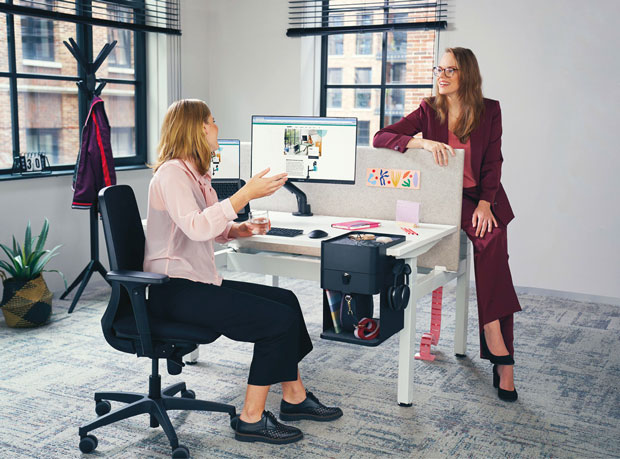Darryl Easton, Managing Director of East On Commercial Interiors with an update on trends in ergonomic furniture and accessories and some key considerations to help ensure your workplace is safe and comfortable
Many workplace and facilities professionals are juggling the often-competing demands of a distributed workforce, hybrid working practices and, in some cases, the desire to encourage a greater number of colleagues to return to the office. Coming hard on the heels of the challenges posed by the speed through which home working became a necessity in 2020, the furniture industry has been quick to develop solutions that support recent changes in the workplace.
The basics still remain though: Health and Safety Display Screen Equipment (DSE) regulations apply to all businesses with DSE users – those who use PCs, laptops, tablets or smartphones daily for continuous periods of an hour or more. It’s about so much more than simply new desks and chairs, what’s required is assessment of each colleague’s full workstation set up.
DSE regulations require yearly assessments and time should be allocated as well for the education of teams in how to fully use their ergonomic equipment. Staff turnover and the need to assess some colleagues more frequently if they have an injury also needs to be factored in.
BUSINESS BENEFITS
Chartered Physiotherapist and Ergonomics Consultant, Angela Yates of Ergonix, advises that as well as complying with current legislation, there are fundamental business benefits for prioritising ergonomics through reducing injury from postural problems and eye strain, to reduce sick leave and even compensation claims. It’s estimated that 65-80 per cent of us will experience lower back pain at least once in our life, and as we all know how hard it is to concentrate on a task when in pain, good ergonomics can help boost productivity.
Ultimately, it’s about enabling our teams to feel that their employer is looking after their welfare and key to this is establishing a culture that encourages breaks for movement and stretching without colleagues feeling self-conscious. Interestingly, Yates notes that northern European countries encounter less workplace injuries because they’ve a more established culture of break out areas in workspaces designed to allow teams to stretch and even exercise.
MAKING A CHOICE
When it comes to sourcing new equipment, the range of furniture and accessories on the market is ever evolving, so we always work alongside partners with deep expertise in this sector to ensure we have access to the latest ergonomic thinking. One of our key advisors is Nicola Horn from ergonomics specialists, Dataflex, who explains that the ergonomic workplace can be broken down into three aspects: creating the best possible working environment, encouraging an active workplace and providing optimum workstations with features that enhance productivity and keep teams healthy.
New products specifically designed for ergonomic working include:
Specialist laptop tables specifically designed for breakout areas. In the past, these have tended to be too small, resulting in the user leaning across from soft seating. Instead, new models are height adjustable tables that come to the user.
Bento Desktop Lockers. With the move to hybrid working meaning that staff don’t work from the same desk, new office projects tend to dispense with pedestals in favour of lockers; a desktop locker slides in next to the user and works with a sit/stand desk so there is no need to bend over to retrieve items. These lockers also have electrification for ease of mobile phone charging.
Addit Bento Ergonomic Toolbox 900. Inspired by the classic Japanese lunchbox, this toolbox not only stores personal items inside it but ergonomically supports devices and documents. The added benefit of this product is that it can be stored in a locker and the user can then touchdown anywhere and start working, even from home.





